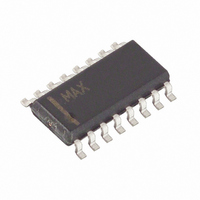MAX4295ESE+ Maxim Integrated Products, MAX4295ESE+ Datasheet - Page 11

MAX4295ESE+
Manufacturer Part Number
MAX4295ESE+
Description
IC AMP AUDIO PWR 2W MONO 16SOIC
Manufacturer
Maxim Integrated Products
Type
Class Dr
Datasheet
1.MAX4295ESET.pdf
(15 pages)
Specifications of MAX4295ESE+
Output Type
1-Channel (Mono)
Max Output Power X Channels @ Load
2W x 1 @ 4 Ohm
Voltage - Supply
2.7 V ~ 5.5 V
Features
Depop, Short-Circuit and Thermal Protection, Shutdown
Mounting Type
Surface Mount
Package / Case
16-SOIC (3.9mm Width)
Lead Free Status / RoHS Status
Lead free / RoHS Compliant
An output filter is required to attenuate the PWM switch-
ing frequency. Without the filter, the ripple in the load
can substantially degrade efficiency and may cause
interference problems with other electronic equipment.
A Butterworth lowpass filter is chosen for its flat
passband and nice phase response, though other filter
implementations may also be used. Three examples
are presented below. The filter parameters for bal-
anced 2-pole (Figure 4b) and 4-pole (Figure 4d)
Butterworth filters are taken from Electronic Filter
Design Handbook by Arthur B. Williams, McGraw Hill,
Inc. These filter designs assume that the load is purely
resistive and load impedance is constant over frequen-
cy. Calculation of filter component values should
include the DC resistance of the inductors and take into
account the worst-case load scenario:
• Single Ended 2-Pole Filter (Figure 4a)
where ω
choosing f
30µH.
A single-ended 2-pole filter uses the minimum number
of external components, but the load (speaker) sees
the large common-mode switching voltage, which can
increase power dissipation and cause EMI problems.
Figure 4a. Single-Ended 2-Pole Filter
Figure 4b. Balanced 2-Pole Filter
OUT+
OUT-
OUT+
OUT-
C = 1 / (√2
o
o
= 2
= 30kHz and R
✕
π
______________________________________________________________________________________
✕
✕
R
f
L
o
L2
L1
L
✕
(f
ω
o
o
L
= filter cutoff frequency);
), L = √2
= 4Ω, C = 0.937µF, L =
C1a
C1b
C
Mono, 2W, Switch-Mode (Class D)
✕
Output Filter
R
L
/ ω
o
R
R
L
L
• Balanced 2-Pole (Figure 4b):
A balanced 2-pole filter does not have the common-
mode swing problem of the single-ended filter.
C = 2 / (√2
f
L1b = 15µH.
A single capacitor connected across R
C
C1b. However, the configuration as shown gives an
improved rejection to common-mode signal compo-
nents of OUT+_ and OUT-_. If the single capacitor
scheme is used, additional capacitors (Ca and Cb) can
be added from each side of R
quency short to ground (Figure 4c). These capacitors
should be approximately 0.2
• Balanced 4-Pole Filter (Figure 4d)
A balanced 4-pole filter is more effective in suppress-
ing the switching frequency and its harmonics.
For the 4-pole Butterworth filter, the normalized values
are: L1
0.3827.
The actual inductance and capacitance values for f
30kHz and a bridge-tied load of R
L1 = (L1
(2
C2b = (2
Figure 4c. Alternate Balanced 2-Pole Filter
Figure 4d. Balanced 4-Pole Filter
o
Audio Power Amplifier
L
✕
= 30kHz and R
= 1/(√2
OUT+
OUT-
ω
OUT+
OUT-
o
N
) = 11.5µH, C1 = C1
N
= 1.5307, L2
✕
✕
✕
C2
✕
R
R
R
L
N
L
L
) / (2
) / (R
✕
✕
L1b
L1a
ω
L
ω
o
o
L
= 4Ω, C1a = C1b = 2.0µF, L1a =
), can be used in place of C1a and
✕
C1
), L = (√2
N
✕
ω
= 1.0824, C1
L2
ω
L1
o
) = 16.24µH, L2 = (L2
o
) = 1.0µF.
N
✕
L2b
/ (R
L2a
Ca
Cb
C
✕
L
L
, providing a high-fre-
L
R
.
L
✕
L
= 4Ω are given by:
)/(2
ω
N
C2a
C2b
o
L
= 1.5772, C2
) = 2.1µF, C2a =
C
✕
, with a value of
L
ω
o
); choosing
R
N
R
L
L
✕
R
O
N
L
11
) /
=
=






